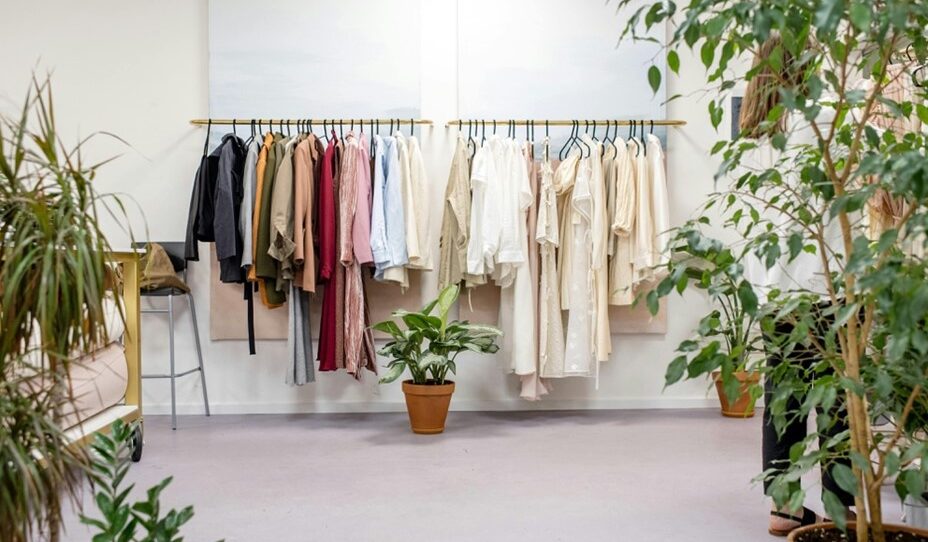“Eco-friendly materials!” “Responsibly made for every generation!” “Slow-fashion process!”
These types of blurbs are being printed on more and more clothing labels – and help assure consumers that they’re making the “right” choices from a wide landscape of available options. But what do these phrases actually mean? It’s easy to include sustainability messaging in advertising, but what actions are being taken to back these words? And who is the judge of whether they’ve been taken? Here at Material Exchange, we’re working to help drive sustainable fashion; keep reading for some insights on how best to communicate around it.

The European Union (EU) has discovered over 200 types of “ecolabels” in the EU market around fashion items for sale – that is, according to the UN Environment Programme’s Sustainable Fashion Communication Playbook released earlier this year. The practical guide, co-published by UNEP and UN Climate Change, offers the tools that fashion communicators (marketers, influencers, media and more) need to align consumer-facing communication across fashion while taking into account sustainability targets.
Within its 102 pages, this playbook highlights the need to focus on the truth around sustainability and circularity in fashion messaging – and to actively avoid:
- spreading misinformation and
- encouraging overconsumption.
Given the power marketing has in helping to shape consumer desire, this is a pretty important change that couldn’t come at a better time.
Ed Stoner, an independent consultant who specializes in the marketing of sustainable materials, has a vast range of experience supporting brands as they tell their sustainability stories. He’s also a member of Material Exchange’s Fashion Advisory Board. We recently caught up with him to discuss how brands can share their low-impact actions.
“There’s a lack of standards and guidance across the industry,” says Stoner. “Without that baseline of what terminology means, it’s nearly impossible to know what you can say.”
Case in point: the examples at the top of this page along with the 200+ other labels discovered by the EU. What does it mean to create a “sustainable” tee-shirt? Is it one that the Earth’s resources can sustain? And if so, does it become unsustainable when the Earth’s resources are depleted?

Getting the sustainability message out there
According to Stoner, the most important considerations when it comes to eco-messaging are to deliver compelling, credible information. This combination offers both the storytelling aspect that attracts attention as well as the data to back up what’s being said as true.
“A lot of brands simply use sustainability terms and assume that’s enough to bring a story to life and persuade consumers to shop sustainably,” says Stoner. “But to me, it requires an additional layer of storytelling beyond just labelling a garment as ‘Made with organic cotton’. You also need to demonstrate why the consumer should care.”
Stoner’s suggestions follow suit with the Sustainable Fashion Communication Playbook, which advises leading communication with science, but also incorporating a cultural layer into messaging which helps consumers to change their behaviors or reimagine values. For example, messaging can shift focus by highlighting wellbeing, equity, and community as sources of joy rather than the accumulation of physical objects. This combination offers both transparency and evidence paired with an attainable vision for consumers, which influences their own actions.
Stoner says a way to weave the story into a narrative is by offering a glimpse of the process behind a piece of clothing. He also stresses the need to think of sustainability holistically, integrating it with the normal rules of marketing by talking about the benefits of a product instead of solely its sustainability.

“Thinking about sustainability in the context of consumer needs and behaviors rather than an isolated topic is something brands need to do more of,” says Stoner. “There’s often a disconnect between the sustainability theme and the marketing perspective and consumer understanding. The most successful sustainability storytelling happens at the intersection of all these things – things that consumers are inspired by, that are better for the planet, and that are financially viable within our current economy.”
The current economy, of course, is an important factor in this puzzle of fashion commerce. Prices are increasing, demand is uncertain, and it’s getting harder to reach bottom lines. Sustainability has a reputation for being pricier than traditional alternatives – but this narrative isn’t always true. Excess materials known as deadstock are a sustainable material option that’s affordable and available without delay.
As the Sustainable Fashion Communication Playbook says, the sustainable option needs to be the more attractive one in terms of personal gain as well as social and environmental benefit. This applies to all stakeholders involved, including the suppliers who choose which materials to sell and the consumers who select the final products. Deadstock lowers the barrier to entry into this coveted sustainability realm – and offers a win-win scenario that’s impossible to duplicate.
If you’re interested in learning more about deadstock and the options it presents for your next collection, check out our showroom of deadstock materials here:
In the meantime, keep striving to make improvements, however small, within your piece of fashion. And carefully consider the communication around your endeavors as a critical component of your efforts.
“No one has this all figured out,” says Stoner. “There is a role for creators, activists, and pragmatists alike.”
We’re all learning from each other on this new sustainability frontier – so let’s learn together.
Related content
Want to chat?
We’d love to hear from you. Reach out to see how we could work together.





